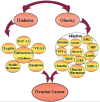Metabolic risk factors of ovarian cancer: a review
- PMID: 34751020
- PMCID: PMC9118962
- DOI: 10.5935/1518-0557.20210067
Metabolic risk factors of ovarian cancer: a review
Abstract
Ovarian cancer continues to be the leading cause of death from gynecological cancers. Despite inconsistent results, patients with metabolic abnormalities, including obesity and diabetes mellitus (DM), have poorer outcomes, showing a correlation with ovarian cancer incidence and ovarian cancer survival. Since ovarian cancer is the most common cancer in women, and considering the increasing prevalence of obesity and DM, this paper reviews the literature regarding the relationship between the aforementioned metabolic derangements and ovarian cancer, with a focus on ovarian cancer incidence, mortality, and likely mechanisms behind them. Several systematic reviews and meta-analyses have shown that obesity is associated with a higher incidence and poorer survival in ovarian cancer. Although more studies are required to investigate the etiological relation of DM and ovarian cancer, sufficient biological evidence indicates poorer outcomes and shorter survival in DM women with ovarian cancer. A variety of pathologic factors may contribute to ovarian cancer risk, development, and survival, including altered adipokine expression, increased levels of circulating growth factors, altered levels of sex hormones, insulin resistance, hyperinsulinemia, and chronic inflammation. Thus, obesity and DM, as changeable risk factors, can be targeted for intervention to prevent ovarian cancer and improve its outcomes.
Keywords: diabetes mellitus; inflammation; insulin resistance; obesity; ovarian cancer.
Figures
References
-
- Al-Sulaiti H, Diboun I, Banu S, Al-Emadi M, Amani P, Harvey TM, Dömling AS, Latiff A, Elrayess MA. Triglyceride profiling in adipose tissues from obese insulin sensitive, insulin resistant and type 2 diabetes mellitus individuals. J Transl Med. 2018;16:175–175. doi: 10.1186/s12967-018-1548-x. - DOI - PMC - PubMed
Publication types
MeSH terms
LinkOut - more resources
Full Text Sources
Medical


